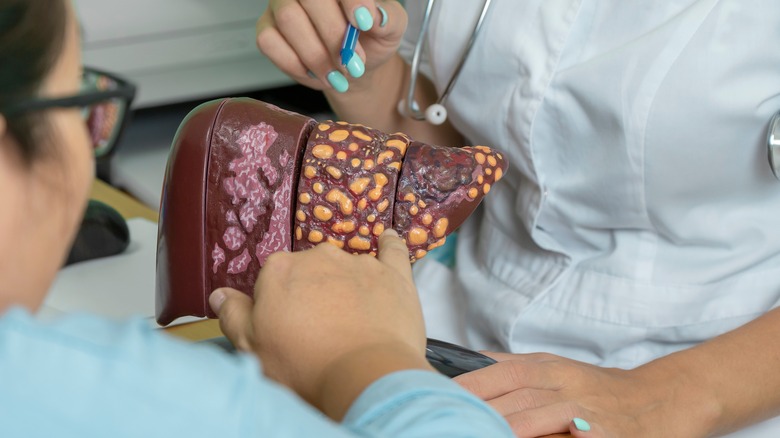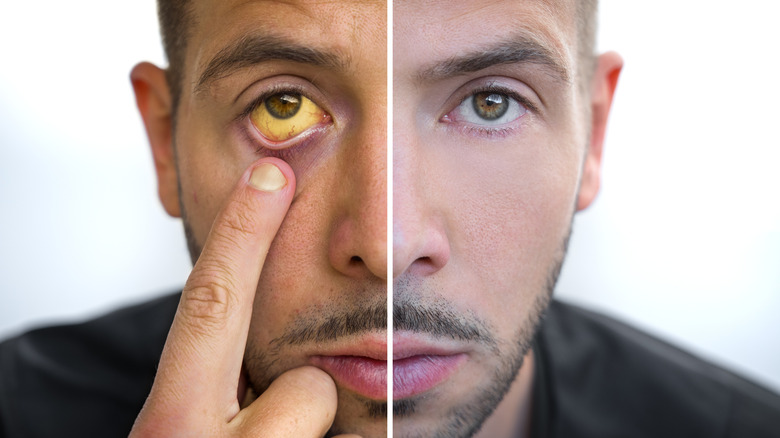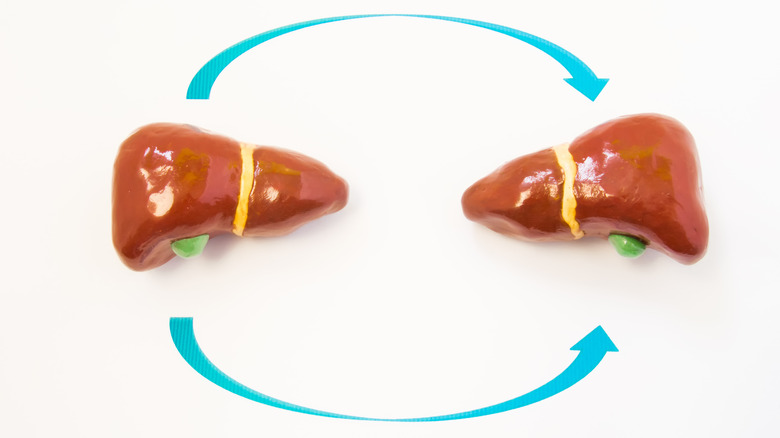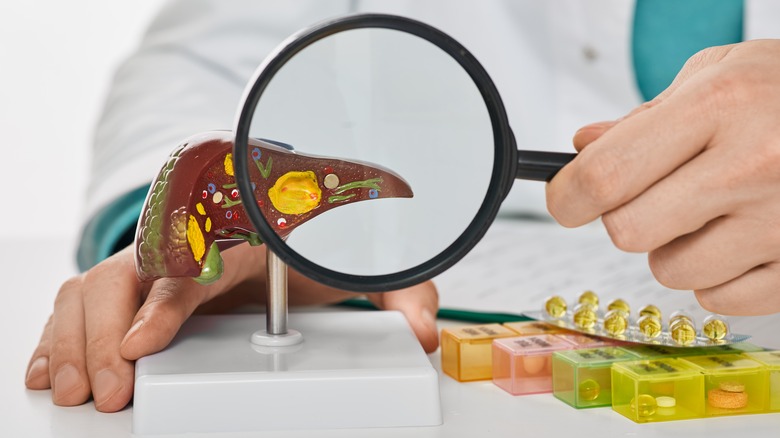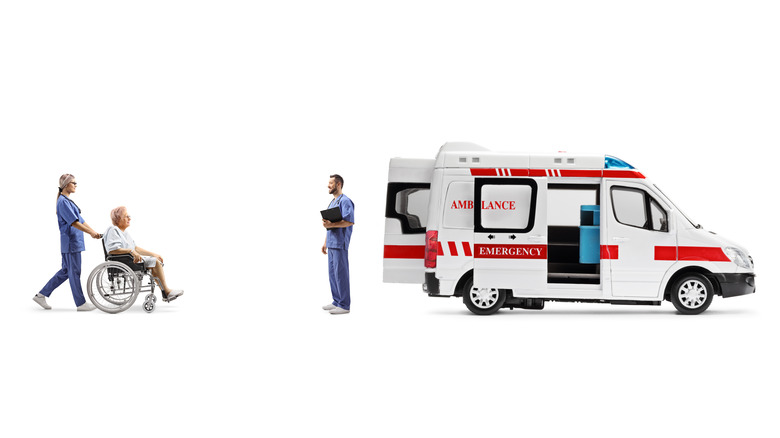Everything You Should Know About Cirrhosis Of The Liver
The human body is often likened to a factory. Just like every part of a factory line, every organ serves unique roles that help maintain normal functions and processes in the body (per The Franklin Institute). The liver is the largest solid organ and is located in the right upper part of the abdomen. According to Johns Hopkins Medicine, it weighs around 3 pounds, and holds 13% of the body's total blood supply. It is made up of two main lobes, thousands of smaller lobules, a complex web of blood vessels, and an intricate network of ducts that eventually combine to form the common hepatic duct. The common hepatic duct is joined by the cystic duct (which is connected to the gallbladder) to form the common bile duct, and eventually drains into the first part of the small intestine (i.e., the duodenum).
According to Columbia University, the liver takes part in over 500 essential processes in the body. All of the blood in the body passes through the liver where waste products, foreign materials, and poisonous products are filtered and removed. This includes removing microorganisms, which in turn helps the body fight off infections. The liver converts and stores glucose as glycogen, and converts it back to glucose whenever the body needs it. The liver also synthesizes albumin (type of protein that helps maintain fluid balance and carries nutrients throughout the body), produces bile (greenish liquid that helps break down fat), regulates amino acid levels and blood clotting factors, and stores vitamins and minerals.
What is cirrhosis of the liver?
The National Institute of Diabetes and Digestive and Kidney Diseases (NIDDK) explains that cirrhosis occurs when healthy liver tissue is replaced by scar tissue. Scar tissue prevents the liver from performing its normal functions and also partially obstructs blood flow to the liver. Initially, the liver is able to tolerate and compensate for the damage. But over time, progressive and widespread scar tissue formation will cause the liver to fail. Hepatic Cirrhosis describes the process in great detail. To put it simply, scar tissue formation occurs through the process of fibrosis. Many cells in the liver can induce fibrosis, mainly as a response to structural damage or exposure to harmful substances.
It is difficult to estimate exactly how many people have cirrhosis, because many people do not experience signs and symptoms until their liver is already significantly damaged. The current estimate in the United States is 1 in 400 adults, or 1 in 200 adults between 45 to 54 years old (cirrhosis is more common in this age group). In reality, the numbers may actually be higher. According to the latest data provided by the Center for Disease Control and Prevention (CDC), in 2020 the top three U.S. states with the highest death rate from chronic liver disease or cirrhosis were New Mexico, Wyoming, and South Dakota, while the state of New York had the lowest death rate.
What causes cirrhosis of the liver?
Liver cirrhosis can be caused by anything that damages the liver. The most common causes include drinking excessive amounts of alcohol, long-term viral infections (i.e., hepatitis B and C), and non-alcoholic fatty liver disease (NAFLD). According to Alcoholic Liver Disease, cirrhosis develops in 30% of people with a long history of consuming more than 40 grams of alcohol per day. To put things in perspective, one drink is equivalent to 13.7 grams (half an ounce) of pure alcohol, which is the same amount found in a 12-ounce beer with 5% alcohol, 8-ounce malt liquor with 7% alcohol, 5-ounce wine with 12% alcohol, and 1.5-ounce 80-proof hard liquor with 40% alcohol. Excessive drinking is defined as more than 21 drinks a week for men, and more than 14 drinks a week for women.
On the other hand, Winchester Hospital states that NAFLD causes fat to accumulate in the liver, but not from alcohol consumption. This can lead to nonalcoholic steatohepatitis (NASH), which can progress to cirrhosis. Conditions associated with NASH include diabetes, obesity, hypertriglyceridemia, coronary artery disease, and long-term steroid treatment.
Per the Cleveland Clinic, other causes of liver cirrhosis include autoimmune hepatitis, inherited disorders (e.g., alpha-1 antitrypsin deficiency, hemochromatosis, Wilson disease, cystic fibrosis, glycogen storage diseases), bile duct diseases (e.g., primary biliary cholangitis, primary sclerosing cholangitis, biliary atresia, gallstones), chronic heart failure, and amyloidosis. Winchester Hospital adds that severe reactions to certain drugs, long-term toxin exposure, and schistosomiasis can also damage the liver and cause cirrhosis.
Signs and symptoms of liver cirrhosis
Because the liver plays a central role in many bodily functions, cirrhosis can cause a wide variety of symptoms throughout the body. During the initial stages of the disease, cirrhosis can be "silent" (cause no symptoms). If it does cause symptoms, they are usually generalized and nonspecific such as weakness, tiredness, nausea, vomiting, loss of appetite, unexpected weight loss, and loss of muscle mass (via Medical News Today).
As the liver gets further damaged and more scar tissue forms, more signs and symptoms specific to liver cirrhosis develop. The Cleveland Clinic enumerates these as easy bruising and bleeding, jaundice (yellow discoloration of the skin or white parts of the eyes), itchiness, edema (fluid retention that collects in the legs, ankles, and feet), fluid retention in the abdomen, abdominal pain and discomfort, tea-colored urine, pale or white stools, dark blood in the stool, redness in the palms, telangiectasias (small, red spots on the skin surrounded by spider-like vessels), confusion, problems with memory, difficulty thinking, and changes in personality. Additionally, men may have decreased libido, enlarged breasts, and shrunken testicles; and women may experience early menopause.
WebMD adds that people with cirrhosis may also have trouble sleeping, white nails, clubbing (rounding of the fingertips), hair loss, nosebleeds, bleeding gums, muscle cramps, and fever.
How is liver cirrhosis diagnosed?
Liver cirrhosis is diagnosed by a doctor using a person's medical history, physical examination, blood tests, imaging, and certain procedures (via NIDDK). Specifically, a doctor will use your medical history to look for risk factors and symptoms that may point to cirrhosis. Risk factors include underlying medical conditions, environmental exposures, alcohol and drug consumption, and previous infections. Following this, a doctor will check your body for signs that are suspicious for cirrhosis. This usually involves examining your skin, listening to your bowels, and palpating and tapping your abdomen to check for any irregularities.
Blood tests can be used to investigate the underlying cause of cirrhosis and to determine how severe the disease is. They may show elevated liver enzymes, increased bilirubin, decreased serum albumin, and signs of infection or anemia. Imaging tests like an MRI, CT scan, ultrasound, or elastography may be used to visualize the liver and determine its stiffness. If all of these have been done but the results are inconclusive, a doctor may perform a liver biopsy to check if there is scarring in your liver.
Compensated versus decompensated cirrhosis
According to a 2021 study published in the European Review for Medical and Pharmacological Sciences, cirrhosis can generally be classified under two categories: compensated or decompensated. They differ in terms of clinical features, prognosis, and predictors of mortality. The progression from compensated to decompensated cirrhosis occurs at a rate of 5-7% a year. Once a person enters the decompensated phase, both their duration of hospital stays and mortality risk significantly increase. Less than 50% of people with decompensated cirrhosis survive past five years, especially if their condition is not properly managed and if they do not receive a liver transplant.
In the compensated stage of liver cirrhosis, parts of the liver are already scarred, but the liver is still able to function normally. As the name implies, the liver is still able to compensate in terms of function despite the presence of fibrosis. Months or years may pass before a person starts experiencing symptoms. If they do have symptoms, they are usually mild and nonspecific such as fatigue, itchy skin, weight loss, stomach pain, and confusion (via Hep). The U.S. Department of Veterans Affairs (VA) adds that people with compensated cirrhosis usually survive for more than 12 years, but the presence of varices (dilated veins) increases their likelihood of transitioning to decompensated cirrhosis.
Decompensated cirrhosis describes the stage where complications have already developed. Unfortunately, the average survival time in this stage goes down to around two years. However, decompensated cirrhosis may revert back to compensated cirrhosis if the underlying cause is treated.
The Child-Pugh score, MELD score, and PELD score
The Child-Pugh score is a system that can provide an estimated survival rate, monitor disease progression, determine how aggressive management should be, and predict whether a liver transplant is needed (via Healthline). Five clinical aspects are measured: total bilirubin, serum albumin, prothrombin time, ascites, and hepatic encephalopathy. Each of these aspects is given a score of 1, 2, or 3, depending on severity. The higher the score, the more severe the disease. A score of 5 or 6 falls under class A (least severe). People in this class have a one- to five-year survival rate of 95% and can safely undergo surgery. A score between 7 to 9 falls under class B (moderately severe), and survival rate is estimated to be 75%. People under this class may still undergo surgery. Lastly, a score of 10 to 15 is classified under class C (most severe), with a survival rate of 50%. People under this score should not have surgery unless it is for a transplant.
MELD stands for "model for end-stage liver disease." PELD (pediatric end-stage liver disease) is its counterpart for children under 12 years old (per WebMD). These scores help doctors determine how quickly a person may need to get a transplant. The score ranges from 6 to 40, with higher numbers correlating to greater urgency. The score is based on several laboratory test results, and is calculated for anyone who needs a transplant, like those with liver failure from cirrhosis.
Treatment for cirrhosis of the liver
Treatment focuses on the underlying diseases that cause cirrhosis, some of which are curable (via NIDDK). When the underlying illness is treated, especially early on in the disease, cirrhosis can be prevented from worsening and progressing to liver failure.
For example, if excessive alcohol use is the cause, a doctor will advise you to stop drinking. To help you achieve this, they may recommend you join support programs, consult with a therapist, undergo rehabilitation, or prescribe medicines. If alcohol isn't the problem but instead you have NAFLD or NASH, a doctor will help you get better control of your weight and blood sugar through lifestyle changes and possibly prescribing medication. If you have hepatitis B or C, chances are you are already taking, or have already taken, antiviral drugs. One of the best ways you can prevent cirrhosis from getting worse is by making sure that your hepatitis is well-controlled. If the underlying cause of your cirrhosis is autoimmune hepatitis, you may have to take steroids or drugs that suppress your immune system. If you have cirrhosis because of bile duct diseases, a doctor may prescribe ursodiol to slow down liver damage (for primary biliary cirrhosis), or you may have to undergo surgical procedures (via WebMD). For people who have cirrhosis caused by inherited diseases, management often involves continuous monitoring and treatment of symptoms. This entails regular visits to your doctor to make sure that your disease is controlled (per NIDDK).
Complications of cirrhosis of the liver
Liver cirrhosis can cause many complications (via Mayo Clinic). Portal hypertension occurs due to an increase in blood pressure in the portal veins (vessels that bring blood from the intestines and spleen to the liver). This happens because scarring from cirrhosis partially blocks blood flow through the liver. Because of this, the spleen can enlarge due to backup of blood, fluid can accumulate in the legs and abdomen, and blood can be redirected to smaller veins and cause varices. Varices are enlarged veins most often present in the esophagus and stomach. They are prone to bursting caused by high pressures and can cause significant bleeding. This can be further worsened by the liver's inability to produce enough blood clotting factors due to scarring. According to Hepatic Cirrhosis, portal hypertension is the major cause of morbidity and death in people with liver cirrhosis.
Other complications that can arise from cirrhosis include infections, malnutrition, bone disease, increased risk of liver cancer, and hepatic encephalopathy. As Healthline explains, hepatic encephalopathy occurs when the liver is unable to filter out toxins in the blood. These toxins can build up and cause damage to the brain. This can happen to anyone with liver damage, but people with severe cirrhosis are more likely to experience recurrent episodes. Some of the signs and symptoms of hepatic encephalopathy include confusion, forgetfulness, personality changes, movement problems, shaky hands, and seizures.
Can complications of liver cirrhosis be treated?
Complications of cirrhosis can be treated. If you have cirrhosis, your doctor will monitor your for the development of complications, and treat you as early as possible (via Mayo Clinic). For portal hypertension, you may be given medications such as beta blockers to lower blood pressure. You may also receive drugs like diuretics if you have fluid in your legs or abdomen, and you may be advised to reduce your salt intake. If the fluid in your abdomen becomes excessive and is causing problems, your doctor may insert a needle or tube to drain the fluid, and examine it for infection or any irregularities. If you have varices that are bleeding, you need to get medical help right away. You may need to get an endoscopy or surgery so that your doctor can stop the bleeding. If you have an infection, your doctor will give you antibiotics.
The American Family Physician adds that if you have malnutrition, your doctor may advise you to take supplements, or alter your diet to compensate for what you're lacking. If you have hepatic encephalopathy, your doctor may give you lactulose to decrease the amount of toxins in your blood, and may give you rifaximin to prevent future episodes (via Mayo Clinic). If you develop liver cancer, you may need to undergo surgery, chemotherapy, or radiation therapy. If your cirrhosis progresses to liver failure or end-stage liver disease, you will need to get a liver transplant.
Milk thistle and cirrhosis of the liver
Milk thistle is a plant that bears spiky, purple flowers. When people talk about milk thistle from a health perspective, they are referring to the herbal remedy derived from the plant's extract (via Healthline). It contains significantly high (65-80%) amounts of silymarin, which has been found to have antioxidant, antiviral, and anti-inflammatory properties. Specifically, milk thistle has been added to treatment regimens of people with liver disease. Studies suggest that it improves liver function, decreases inflammation, and protects against certain toxins.
Aside from helping treat liver problems, milk thistle may also help promote skin and bone health, reduce cholesterol and insulin resistance, help with weight loss, improve symptoms of allergic asthma, limit the spread of cancer, increase resistance of oxidative stress, and support the immune system (per Medical News Today). All of these benefits look really good on paper, but they are still not clearly understood and require further research. Although milk thistle is generally safe to consume for most people, it should not replace the current and standard treatment of the conditions that it is used for.
It's good to be proactive when it comes to your health, but it's also important that you speak with your doctor first before taking any supplements. Milk thistle can cause side effects and can also affect how some medications work. Your doctor will know if milk thistle is right for you by reviewing your medications and checking how it will affect your current health status.
Cirrhosis of the liver and liver cancer
Liver cancer occurs when cells in the liver start growing out of control (via American Cancer Society). These clumps of cells eventually grow and form a tumor. When cancer begins in the liver, it is called primary liver cancer. There are many different types of primary liver cancer, including hepatocellular carcinoma (HCC), intrahepatic cholangiocarcinoma, angiosarcoma, and hepatoblastoma. When cancer starts from somewhere else and then spreads to the liver, it is called secondary or metastatic liver cancer. These tumors usually originate from nearby organs like the pancreas, stomach, breast, lung, and colon.
A 2016 article by the European Society of Medical Oncology explains that a person with liver cirrhosis is at an increased risk of developing primary liver cancer, as well as other cancers outside of the liver. HCC is the most common type of primary liver cancer. It usually develops in people who have cirrhosis, and can occur at any stage of the disease (i.e., compensated or decompensated). People with cirrhosis who develop liver cancer face additional challenges to treatment because treatment usually involves surgery or procedures that may damage the surrounding normal tissues. Depending on how severe the cirrhosis is, it may be unsafe for a person to undergo surgery, or they can experience further decline in their liver function if the remaining normal tissues get damaged from treatment. Because of these risks, people with cirrhosis are recommended to get an ultrasound to screen for HCC every six months (per American Family Physician).
Can liver cirrhosis be prevented?
The best way to prevent liver cirrhosis from developing is through appropriate and timely screening for chronic liver disease (via American Family Physician). If liver disease is detected early, treatment can be given and the disease can be monitored to prevent it from progressing to cirrhosis. A doctor can screen a person for chronic liver disease by looking at their history, performing a physical examination, and ordering blood tests (e.g., liver function tests, lipid profile) and imaging procedures. If anything seems abnormal, a doctor will further investigate by ordering more specific tests to land at a diagnosis. Once a diagnosis is made, a doctor can begin treatment and monitor the disease to make sure that it is well-controlled.
A person with chronic liver disease will be advised by their doctor regarding things that they need to avoid, change, or pay attention to so that they can have the best chances of preventing cirrhosis (per Cleveland Clinic). Some of these things include avoiding alcohol, maintaining a healthy weight, practicing proper nutrition, exercising regularly, and avoiding unnecessary surgical procedures. A doctor will also review any medications and supplements they are taking to ensure that none of them are causing harm to their liver. People with liver disease should also take the necessary precautions to protect themselves against infections, including being updated with their vaccinations and avoiding high-risk behaviors (e.g., sharing needles for illegal drug use, unprotected sex) which can increase their risk of getting hepatitis.
When to call 9-1-1
If you have cirrhosis, you should call 9-1-1 or go to the nearest emergency room if your stools are dark and tarry or have blood in them (may be dark or bright red in color), if you are vomiting blood, if you feel lightheaded or dizzy, or if you are having trouble breathing (via Mayo Clinic). These may all be signs of ruptured varices. If the bleeding does not get controlled, you may experience significant blood loss which can lead to shock, and possibly death.
You should also seek immediate help if you are experiencing muscle tremors or shaking, if you have fever, or if you notice changes in your memory, mood, behavior, or concentration. According to the National Organization for Rare Disorders (NORD), these are symptoms of hepatic encephalopathy and should be treated immediately. Hepatic encephalopathy is a common complication of cirrhosis, and is estimated to occur in 70% of people with liver cirrhosis (via the American Liver Foundation).
WebMD adds that if you are experiencing severe abdominal pain, or if the white parts of your eyes suddenly turn yellow (i.e, jaundice), you should get emergency treatment as soon as you can. These may mean that bilirubin, a byproduct from the breakdown of red blood cells, is unable to properly move through your liver or bile ducts to be excreted from or recycled in the body. When this occurs, bilirubin accumulates in the blood and gets deposited in the skin and eyes, causing jaundice.
Life with liver cirrhosis
Cirrhosis is not a curable disease, and the complications that are associated with it can be deadly. Like with any other illness, life expectancy decreases as the disease gets worse. According to Medical News Today, in liver cirrhosis, survival can vary greatly from person to person depending on the underlying cause, how much scarring is present, their age, their overall health condition, and how the disease is being managed.
One of the challenging things that come with liver cirrhosis is that you can already have it without knowing it. During the early stages, signs and symptoms may not be present and the only way it can get detected is through screening by your doctor. Therefore, it's important to have regular appointments with your doctor, so that you can catch the disease early on. Healthline mentions that while cirrhosis is typically irreversible, you can help slow its progression by avoiding alcohol, limiting salt intake, practicing good hygiene, and being more vigilant with regards to taking over-the-counter drugs. The VA states that non-steroidal inflammatory drugs (NSAIDs) such as aspirin, ibuprofen, and naproxen should be avoided because they can cause kidney damage in people with cirrhosis. Iron supplements should also be avoided, as well as other medications that can further damage the liver. The best way to know if a medication is right for you is by consulting with your doctor or pharmacist first before taking them.

